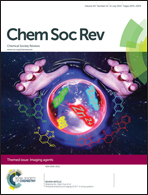BODIPY-based probes for the fluorescence imaging of biomolecules in living cells
Abstract
Fluorescence imaging techniques have been widely used to visualize biological molecules and phenomena. In particular, several studies on the development of small-molecule fluorescent probes have been carried out, because their fluorescence properties can be easily tuned by synthetic chemical modification. For this reason, various fluorescent probes have been developed for targeting biological components, such as proteins, peptides, amino acids, and ions, to the interior and exterior of cells. In this review, we cover advances in the development of 4,4-difluoro-4-bora-3a,4a-diaza-s-indacene (BODIPY)-based fluorescent probes for biological studies over the past decade.

- This article is part of the themed collections: Celebrating the ChemSocRev Lectureship winners and Imaging Agents

 Please wait while we load your content...
Please wait while we load your content...